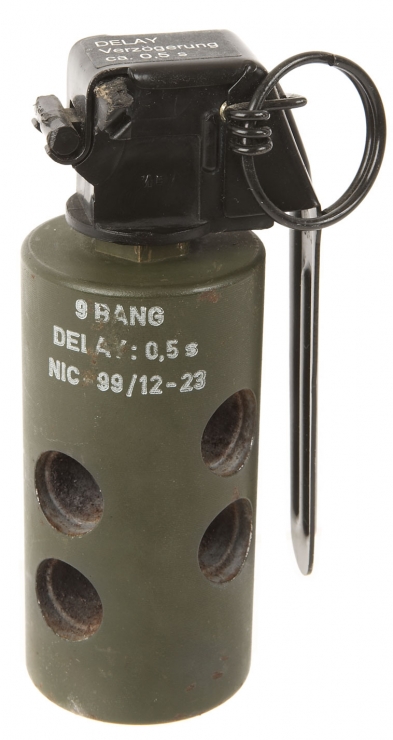 |
| M84 Flashbang Grenade |
I woke up this morning, at 5:15 a.m. to a loud sound that I was sure was a gun shot. I could feel vibration from the noise in my chest and I could tell that it was happening just outside my window. Without stirring, I waited and listened for something else to happen. I heard violent yelling, then at least three more shots followed, each accompanied by a bright flash of light that filled my room. I heard a person scream and then the words: “break it open, just break it open.” I could tell that the sounds were clearly coming from my next door neighbor’s backyard but then I heard people walking right next to my bedroom window – on my side of the fence. Lying still in bed, I felt like a person with post traumatic stress disorder who brings the battlefield home win their nightmares, except what woke me up was not a dream. Harshly disquieted, I grabbed a bat and went looking for a cordless phone to call 911. After a half-hour of suspecting a violent crime I finally got a hold of the local watch commander who told me that police had served a warrant next door and used flashbangs to gain entry. Flashbangs, also known as stun grenades, are used as incapacitants by law enforcement and the military to subdue and disorient. The grenades detonate with a flash of light that maximally activates all light sensitive cells in the eye, making vision impossible for about five seconds while also producing a blast of sound that disturbs fluid in the inner ear producing mental disorientation.
Once I was apprised of the fact that the noises I heard were law enforcement and not criminal I felt much better. I knew I was no longer in danger. My cat Niko on the other hand, couldn’t understand this and he was engaged in all kinds of nervous behavior that I have never seen from him. I tried my best to calm him but was disappointed that I couldn’t communicate to him that we were safe now. I quickly grabbed my things and left for the bus in an effort to make the 8:00 a.m. statistics discussion section that I teach. On the way out, I saw a swat truck and about 15 camouflaged, masked, heavily-armed men. These images were poignant but I tried to move on mentally with my day. I also tried to become aware of my memories of the event and aware of my responses to it.
Memories of surprising or traumatic events are thought to be much more accessible and are called flashbulb memories. Flashbulb memories are exceptionally vivid “snapshots” of a surprising or consequential event. Highly resistant to forgetting, these autobiographical memories are distinctive, contextually inflexible and thought to represent an adaptive, biological response aimed at preserving information about injurious or otherwise noteworthy circumstances. Studies have shown that, unlike most contextual memories that necessitate the involvement of higher-order association areas (such as the PFC and mediotemporal lobe), flashbulb memories can be brought quickly to consciousness without sustained thought. Thus it seems that our brains are equipped to rapidly reconstitute imagery about fearful or emotionally arousing situations. Normally, when higher-order areas are involved, we need a large number of coactivated representations to drive specific memorial imagery. Flashbulb memories on the other hand, can be brought back in full force with the coactivation of just a few relevant representations.
When I got back from school, stimuli at home were evoking flashbulb memories. I looked at my bedroom window and clearly heard the words, “break it open.” I didn’t summon these words, I didn’t want to hear them. My amygdala and other subcortical brain areas activated the circuits responsible for the words after being triggered by the environment. Clearly, intrusive imagery like this is more frequent and more vivid in schizophrenia or in drug-induced episodes of psychosis. Normally, the areas that cue up this invasive imagery serve as protective devices that are innately sensitive to loud noises, fast movement and threats of danger. Here this form of memory is working against me but in the hunter-gatherer past they would have been forced me to take precautions necessary to ensure my survival.
My conscious self knew better, knew that there was no real danger. But, like my cat, other unconscious brain areas and neural circuits - that don’t speak English - didn’t know this. These unconscious brain modules, like small, scared animals, continued to be emotional simply because they do not have access to the explicit, declarative knowledge that there was no real threat.
No comments:
Post a Comment